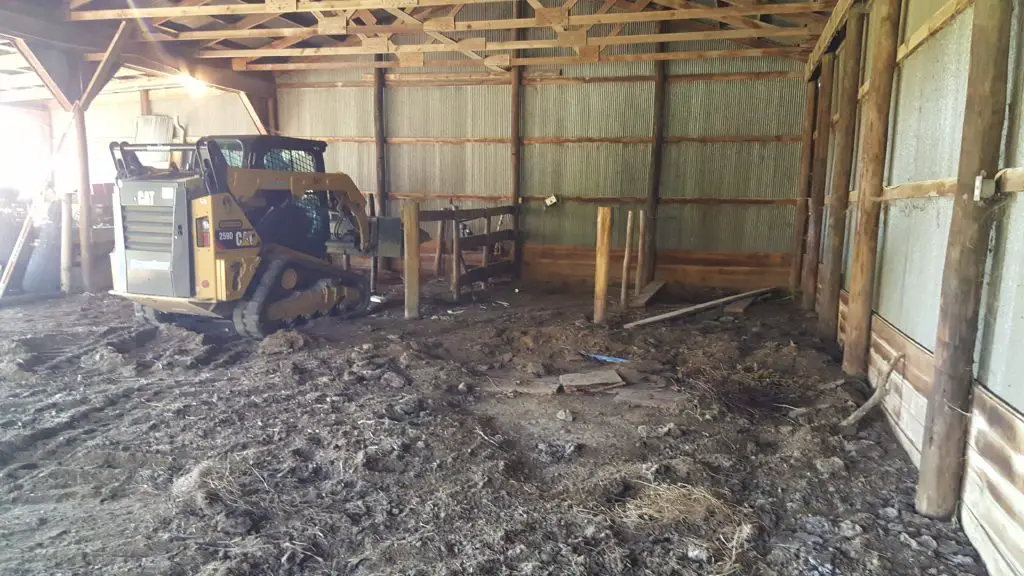The crisp autumn air rolled in, and with it came the annual ritual of packing away summer gear and prepping the garage for winter. This year, however, something felt different. I watched my wife shivering as she organized boxes, her breath visible in the chilled air. That’s when it hit me: the garage was a frigid workspace. Determined to make the space more inviting, I set out to research the best way to add floor heating. My journey led me to a world of possibilities, from electric radiant systems to hydronic options. Ultimately, I found a solution that not only warmed the garage but also improved its overall comfort and functionality.

Image: podunkliving.com
Adding floor heat to an existing garage is a project that requires careful planning and consideration. It’s not just about flipping a switch and instantly having a toasty workspace. There are various factors to weigh, including the size and layout of the garage, the type of existing flooring, and your budget. But with the right information and a bit of effort, you can transform your cold garage into a year-round haven for hobbies, projects, and even hanging out with friends.
Understanding Your Options: A Look at Floor Heating Systems
Electric Radiant Heating
Electric radiant heating systems utilize thin, flexible heating mats or cables that are installed beneath the flooring. Electricity runs through these components, warming the floor surface, which in turn radiates heat into the room. This method is known for its efficiency, quiet operation, and ease of installation, especially in existing garages.
Electric radiant heating systems come in various forms:
- Thin Cable Systems: These offer flexibility and are suitable for underlayment or thin tile installations.
- Heating Mats: Pre-assembled mats are designed for quick installation beneath tiles or laminate flooring.
Hydronic Heating
Hydronic heating, or “wet” heating, involves circulating hot water through a network of pipes installed beneath the flooring. The heat is then transferred to the room through the floor surface. Hydronic systems are known for their energy efficiency and long-lasting performance. However, they require more complex installation, as they need a boiler or heat pump to heat the water.
Hydronic heating offers several advantages:
- High Efficiency: Hydronic systems are highly energy-efficient, converting most of the energy consumed into heat.
- Even Heat Distribution: The evenly distributed warmth provides a comfortable and consistent temperature throughout the space.

Image: alansfactoryoutlet.com
Choosing the Right System for Your Garage: Factors to Consider
The best floor heating system for your garage depends on several factors, including:
Budget:
Electric radiant heating systems are generally less expensive to install than hydronic systems. However, the long-term energy savings associated with hydronic heating can compensate for the initial higher cost.
Floor Covering:
The type of flooring you have installed can influence the choice of heating system. Electric radiant heating is compatible with a wide range of floor coverings, including tile, laminate, and even concrete. Hydronic heating is often best suited for thicker floor coverings, such as tile, due to the presence of plumbing pipes beneath the surface.
Space Requirements:
The size and layout of your garage must be taken into consideration. Electric radiant heating systems are generally easier to install in small spaces due to the system’s simplicity. Hydronic heating systems can be more challenging to install in smaller garages due to the need to run plumbing pipes beneath the flooring.
Existing Plumbing:
If you’re considering a hydronic heating system, you’ll need to assess your existing plumbing infrastructure. Does the garage have access to hot water lines, or will you need to install a new boiler or heat pump? This is a critical factor in the decision-making process.
Energy Efficiency:
Both electric radiant heating and hydronic heating can be energy-efficient options. Consider your climate and usage patterns to determine which technology would be more efficient for your needs. Electric radiant heating systems are often better suited for quick bursts of heat, while hydronic systems excel at providing consistent temperature control.
Installation Tips and Tricks
Here are some tips to ensure a successful floor heating installation in your existing garage:
1. Adequate Insulation:
Before installing a floor heating system, it’s crucial to ensure proper insulation for your garage. Insulation helps prevent heat loss and significantly improves the system’s efficiency.
2. Careful Installation:
Whether you choose electric or hydronic heating, proper installation is essential for optimal performance and longevity. If you’re not a skilled DIYer, it’s recommended to hire a qualified contractor with experience in floor heating installations.
3. Floor Preparation:
Prepare the floor surface thoroughly before installation. This may involve leveling the floor, removing existing loose debris, and ensuring adequate drainage.
4. Thermostat Placement:
Choose a strategic location for your thermostat to ensure accurate temperature control. Consider having the thermostat in an area where people typically gather in the garage.
The decision of whether to use electric or hydronic heating depends on your specific needs and preferences. Each system offers unique advantages and disadvantages, so carefully weigh the factors discussed above before making your final choice.
Frequently Asked Questions
- Q: Does adding floor heating to my garage increase its value?
A: Yes, adding floor heating can potentially increase the value of your garage. It improves the functionality and usability of the space, making it more attractive to potential buyers.
- Q: How much does it cost to install floor heating in a garage?
A: The cost of floor heating installation varies depending on the size of the garage, the type of heating system chosen, and the labor costs in your area. You can expect to pay anywhere from $3 to $10 per square foot for installation.
- Q: Is floor heating safe for garages?
A: Floor heating systems are generally safe when installed correctly. However, be sure to follow all manufacturer’s instructions and consult with a qualified electrician or plumber.
- Q: How can I save money on floor heating costs for my garage?
A: You can reduce energy consumption and save on costs by:
- Using a programmable thermostat to adjust the temperature based on your usage patterns.
- Properly insulating the garage to prevent heat loss.
- Choosing energy-efficient floor heating components.
Adding In Floor Heat To Existing Garage
Conclusion
By adding floor heat to your existing garage, you can transform a cold, often neglected space into a comfortable and inviting workspace, hobby area, or even a gathering spot for friends and family. Whether you opt for electric radiant heating or hydronic heating, this investment can enhance your enjoyment of your garage throughout the year.
Interested in exploring the possibilities of floor heating in your garage? Let us know in the comments below!





